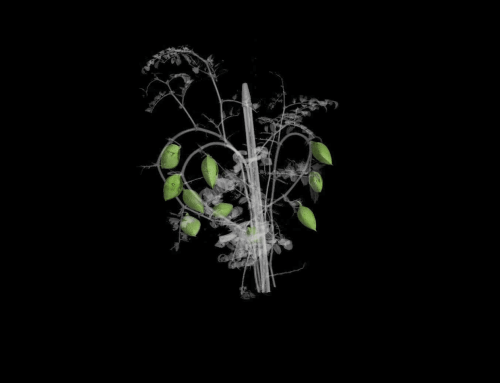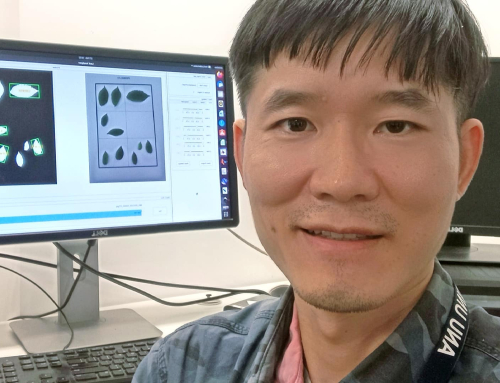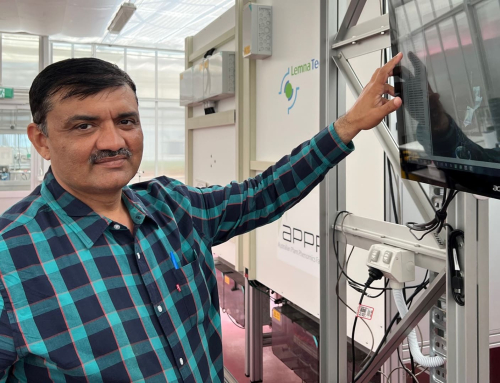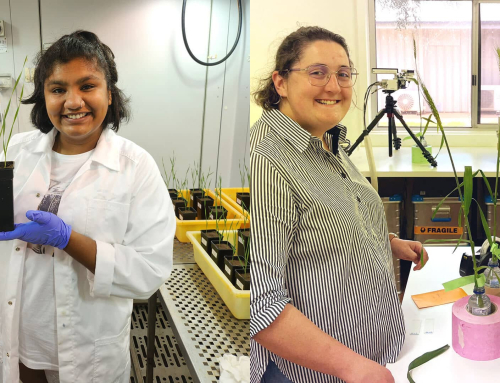Exciting research is carried out every day by users of the APPF’s technology and facilities. Here we share another inspirational story….
The potential to significantly increase wheat yields has been demonstrated in South Australian trials – of experimental genetically modified (GM) wheat lines.
These lines ‘overexpress’ three wild-type plant genes, either individually or in combination, and were developed to test whether targeting individual wheat genes could lead to improvements in yield.
In greenhouse studies carried out at the Australian Plant Phenomics Facility, yield gains from the best performing lines were in the range of 32 to 50 per cent, compared to the same germplasm lacking the GM trait.
The material was also tested in field trials in 2018 in SA and at the Mexican research station of the International Maize and Wheat Improvement Centre (CIMMYT).
In a preliminary field trial in SA, some of the GM lines still outperformed the controls, delivering yield gains of between 20 to 30 percent. The results are promising, but need to be validated with additional field trials in different environments.
To look at, the GM plant lines are bigger, which is associated with higher plant biomass and more tillers or more grain per head.
The trait’s inventor, Associate Professor Stuart Roy of the University of Adelaide, says there are no plans to commercialise the GM lines.
In a preliminary field trial in SA, some of the GM lines still outperformed the controls, delivering yield gains between 20 to 30 percent.
“There are no GM wheat varieties grown anywhere in the world,” Associate Professor Roy says.
“That is extremely unlikely to change in the near future.”
Instead, the GM work served as proof of concept. It permitted the mass screening of transgenes from different plant species in order to identify those that produce beneficial traits when overexpressed in wheat.
Once identified, the wheat counterpart of the transgenes became the basis of a conventional breeding strategy.

Conventional counterparts
Work is well advanced at the Adelaide laboratories in developing conventional versions of the GM traits.
This entailed two distinct steps.
Firstly, since the genes used in the GM lines were actually sourced from rice and Arabidopsis genomes, wheat analogues of these genes had to be identified.
However, the complexity of wheat genetics – given the co-existence of three distinct progenitor genomes – meant that multiple versions of the target genes were found to co-exist in wheat.
“In total, there were 24 wheat counterparts of the three genes of interest,” Associate Professor Roy says.
“So in going forward, we had to work out which of those 24 genes were most similar to the genes used in the GM lines.
“The ability to interrogate the wheat genome sequence helped us to do that.”
The second stage involved screening the wheat gene pool to identify genetic variants that naturally overexpress the relevant genes.
The best performing variants (or ‘alleles’) are now being introduced by conventional pre-breeding approaches into elite Australian germplasm, including the variety Scepter (PBR).
This breeding is being accelerated through the use of marker-assisted selection (MAS) and speed breeding technology.
To look at, the GM plant lines are bigger, which is associated with higher plant biomass, and more tillers or more grain per head.
“In the future, we are looking to combine pairs and all three alleles into the same wheat line to maximise yield benefits,” Associate Professor Roy says.
In the meantime, the newly developed elite germplasm will next undergo extensive field trials in Australia and Mexico to assess their yield potential in different environments and growing conditions.
Gene editing
Associate Professor Roy adds that the conventional breeding strategy is unlikely to recapture the full yield boost seen with the GM traits since this approach is limited by the diversity naturally available in the wheat gene pool.
Fortunately, newer gene technology – in the form of gene editing – presented Associate Professor Roy with an alternative pathway to more closely mimic the original GM traits.
The aim is to make small changes to the DNA that flanks the target genes since this region functions to regulate gene expression levels.
He thinks edits are possible that will serve to increase gene expression to levels seen in the GM lines.
He will make the attempt using a version of gene editing that was recently classified as non-GM by the Office of the Gene Technology Regulator as of October 2019.
“The gene edited plants are currently being produced, with evaluation of their performance likely to start in late 2019,” Associate Professor Roy says.
Fortunately, newer gene technology – in the form of gene editing – presented Associate Professor Roy with an alternative pathway to more closely mimic the original GM traits.
International collaborations
While these discoveries have been years in the making, Associate Professor Roy’s research has most recently been conducted within the International Wheat Yield Partnership (IWYP).
IWYP is a globally important initiative that seeks to increase wheat’s yield potential by 50 per cent by 2035 in order to avoid projected shortfalls in supply.
IWYP projects rely on top researchers from around the world forming research partnerships that tap complementary skills across several laboratories.
The teams then bid competitively for funding from a pool of US$100 million, with GRDC funding supporting Australian-based research activities.
Associate Professor Roy heads one such international program and he collaborates with other research groups from around the world that bring additional capacities into play.
Included is a team led by Alex Johnson, at the University of Melbourne, and Sigrid Heuer, at Rothamsted Research (UK), that are also involved on the gene side of the program.
There are also groups that specialise in understanding the physiological mechanism by which genes produce desirable changes in performance.
This helps to refine ongoing research opportunities. Involved are Roberto Gaxiola, at Arizona State University, (USA) and Julia Bailey-Serres, at the University of California, Riverside (USA).
Finally, there is Ravi Valluru, at CIMMYT (Mexico), who runs field trials with the GM lines at CIMMYT’s transgenic facilities.
When it came to identifying naturally occurring variation in wheat gene expression, Associate Professor Roy additionally gained access to resources developed by other IWYP projects that are sequencing diverse wheat panels and landraces to make better use of naturally occurring variation.
“These IWYP projects talk to each other and we are finding ways to maximise the impact from our work by helping each other out,” Associate Professor Roy says.
“That’s one of the beauties of the IWYP initiative.”
The three genes
Associate Professor Roy says that GM technology was used in the first instance because it allowed a large number of plant genes to be overexpressed in wheat and then efficiently screened for impacts across a range of performance parameters.
“Hundreds of genes had to be tested before we found the three that have such profound impacts on yield potential,” he says.
The three genes and their likely trait mechanisms are:
- AVP1 (Vacuolar Proton Pyrophosphatase 1) – improved sugar transport from source to sinks; enhanced root growth and nutrient uptake; and increased shoot biomass and tiller number resulting in a bigger plant.
- PSTOL1 (Phosphorus Starvation Tolerance 1) – enhanced root growth and nutrient uptake; and increased shoot biomass and tiller number.
- NAS (Nicotianamine Synthase) – increased shoot biomass and tiller number.
Each of the three genes affects plant physiology differently, but wheat appears to tolerate having all three mechanisms modified at once. Although, Associate Professor Roy is planning to check for unintended impacts on characteristics, like grain quality.
“We saw additive effects on yield gains from having pairs and all three genes combined,” he says.
“What we are looking at in 2019 is which combinations work best in different environments.”
Associate Professor Roy suspects there may be combinations that are better in water-constrained environments typical of Australian dryland farming systems.
He says other combinations may do better in less marginal environments, such as lines that produce a lot of biomass.
“What we need to do going forward is to run trials at multiple sites and seasons,” he says.
“But based on the data we have so far, the results are looking promising.”
More information: Stuart Roy, stuart.roy@adelaide.edu.au
GRDC Research Code: ACP00009
Article by: Dr Gio Braidotti, GRDC, GroundCover
The APPF is an NCRIS-enabled facility offering open access, affordable fee-for-service research facilities, plant phenotyping technology and expertise to ALL academic and commercial researchers. From pilot tests and one-off research projects in controlled environments to large-scale, long term research projects in the field, our multi-disciplinary team can provide the technology, data management and expertise you need to help answer your research questions. Contact us for more information on how we can help you.





